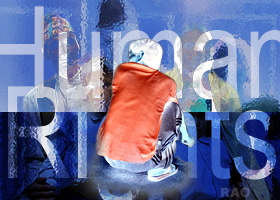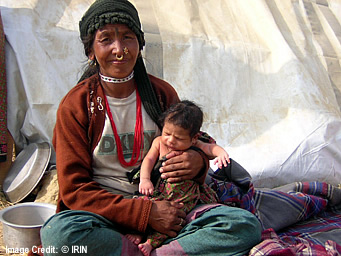|
Nepal
in Crisis 2006: Human Rights
|
|
IDP
return still a trickle despite ceasefire
|
 |
16
October 2006 (IDCM)
Nearly
six months after nationwide protests forced the king to end 14 months of
absolute rule and the Maoists rebels called a ceasefire, only a few thousand
people have reportedly returned to their homes, the majority of the internally
displaced persons (IDPs) preferring to wait for better security guarantees
and more assistance to make the journey home. Although no reliable figures
exist, it is estimated that up to 200,000 people have been internally displaced
in Nepal by ten years of war, which has claimed more than 13,000 lives
and affected all districts of the country. Caught between two evils, abuses
by the Maoists and repression by the security forces, most people have
also fled the general deterioration of the socio-economic conditions in
the countryside and sought refuge in district headquarters or in the main
urban centres. The war has also thrown hundreds of thousands of people
onto the road to India - a traditional migration route for Nepalese.
 |
|
| A
12-point agreement signed in November 2005 between the CPN-Maoist and the
Seven Party Alliance had already encouraged some timid return movements
of IDPs to their homes. The ending of the armed conflict and repeated commitments
by the rebels to respect the rights of IDPs paved the way for more returns,
in particular in the eastern and mid-western regions. However, continued
human rights abuses by the Maoists, including killings, abductions and
torture, have so far prevented largerscale return movements. These are
also hampered by the absence of government representatives at the village
level, these having been displaced themselves, as well as by the lack of
a government return plan. |
|
The
government issued a national IDP Policy in March 2006, but as with previous
IDP plans, the latest failed to comply with international standards as
it only recognised as IDPs those displaced by the actions of Maoists. Although
initially slow to move from the development into the humanitarian gear,
the response of the international community is now taking shape, spearheaded
by UNHCR and OHCHR as lead agencies for IDP protection. While peace talks
are now ongoing and many IDPs are on the verge of returning, both the government
and the Maoists should do more to live up to their commitment to provide
assistance to all categories of displaced and ensure that their return
can take place in a safe and sustainable manner.
top
 |
|
Internally
displaced people
|
|
Background
and main causes of displacement
|
 |
 |
| The
"People's War" was launched by the Maoists (CPN-M) in 1996 with
the aim of overthrowing the constitutional monarchy and establishing a
socialist republic. Despite the reinstatement of a multiparty democracy
in 1990 and a new constitution, which followed three decades of panchayat
(nonparty) system of government, Nepal's political order continued
to be dominated by the same elite who demonstrated little inclination to
improving the lives and livelihoods of the majority of the rural poor and
largely failed to address the systemic inequality of Nepalese society. |
|
The
insurgency started in the districts of the mid-western region when Maoists
began attacking the police, the main landowners, members of other political
parties, teachers and local government officials. Forced to leave their
land and property or threatened because of their association with the monarchist
regime, many people targeted by the Maoists started moving to district
headquarters where many chose to settle. Using guerrilla tactics and virtually
unchallenged by the government during the first five years, the Maoists
gradually gained ground in other districts of the country. It was not until
the deployment of the army and the declaration of a state of emergency
in late 2001 that the conflict escalated. By then, displacement had also
started to affect other poorer strata of the population who fled fighting
between the rebels and the army, forced recruitment into Maoist ranks and
also the more general effects of war.
In
many areas, the conflict led to the breakdown of education, closure of
businesses, weakening of local economies and interruption of public services.
Insecurity and blockades further reduced the availability of food and exacerbated
a long-standing trend toward rural exodus (SAFHR, March 2005, p. 36). Particularly
after November 2001, when security deteriorated markedly in rural areas,
many people started fleeing to urban district centres, large cities like
Kathmandu, Biratnagar and Nepalgunj, and across the border to India.
In
2001, Prince Gyanendra was crowned king after most of The Former Royal Family
was killed in a bizarre shooting incident in the palace. A year later he
suspended the elected Parliament, installed a prime minister of his choosing
and indefinitely postponed elections, effectively assuming full executive
powers with the support of the army. Although a seven-month ceasefire provided
some respite in 2003, fullscale fighting soon resumed, even gaining in
intensity, while the conflict rapidly spread to all 75 districts of the
country. A pattern emerged, with the rebels more or less controlling the
rural areas and the government's presence mainly restricted to district
headquarters and urban centres. In a desperate effort to regain some control
of the rural areas, the government started encouraging the creation of
"village defence committees" in various districts of the country (ICG,
17 February 2004). Often created by local landlords with the tacit support
of the army, these militias constituted an inflammatory development in
the conflict.
In
February 2005, an anti-Maoist rampage in Kapilvastu district resulted in
the displacement of between 20,000 and 30,000 people to the Indian border
(Bell, Thomas, 12 March 2005; BBC, 14 March 2005; Kathmandu Post, 19 March
2005). On 1 February 2005, the king dismissed the government and declared
a state of emergency giving him absolute power and effectively suspending
all civil liberties (AI, 15 June 2005, p. 4).
In
the wake of the coup, fighting and subsequent human rights abuses increased
significantly throughout the country. While the king gained less understanding
for his coup from the international community than he had hoped for, he
also miscalculated the repercussions at the domestic level. By the end
of the year, the Maoists and the main political parties had reached a common
understanding in the form of a 12-point agreement where they approved a
common platform of action for ending the king's absolute rule and restoring
sovereignty to the people through the reinstatement of Parliament, the
formation of an allparty government and elections to a constituent assembly.
On
24 April 2006, following weeks of nationwide protests, the king ended his
direct rule and reinstated parliament (IRIN, 25 April 2006). At the end
of May, a new interim government and the Maoist leadership agreed on a
25-point Code of Conduct to end the conflict and pave the way for the election
of a constituent assembly, whose task would be to draw up a new Constitution
and lay down the foundation of a new political system to govern the country.
Both sides met for a second round of formal peace talks in early October
and agreed to hold elections for a constituent assembly by June 2007. No
agreement was reached on the main bones of contentions, which include the
future of the monarchy and the disarmament of the rebels (IRIN, 10 October
2006).
Credit:
Internal Displacement Monitoring Centre (IDMC) and Norwegian Refugee Council
2006
top

|







